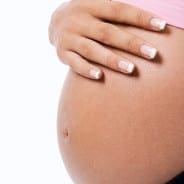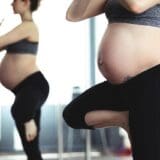During pregnancy, many women experience hip pain due to the changes happening in their bodies. The growing belly puts pressure on the hips, causing discomfort and sometimes even sharp pain. If you’re dealing with pregnancy hip pain, don’t worry, there are several tips and techniques that can help alleviate the discomfort and make your pregnancy journey more enjoyable.
Exercise: Engaging in safe exercises and stretches can be incredibly beneficial in relieving pregnancy hip pain. Low-impact activities like swimming, prenatal yoga, and walking can help strengthen the muscles around your hips and provide relief. It’s important to consult with your healthcare provider or a prenatal fitness specialist to ensure you’re doing exercises that are safe for you and your baby.
Proper Posture: Maintaining good posture is crucial in reducing hip pain during pregnancy. When you slouch or hunch forward, it puts additional strain on your hips and lower back. Practice standing up straight with your shoulders back and your pelvis slightly tucked in. When sitting, use a chair with proper back support and avoid crossing your legs, as it can exacerbate hip discomfort.
Ergonomic Support: Using pillows and supports can provide much-needed relief for pregnancy hip pain. When sleeping, try placing a pillow between your knees to align your hips and reduce pressure. You can also use a pregnancy pillow that supports your belly and hips. When sitting for extended periods, use a cushion or a rolled-up towel to support your lower back and hips.
Sleeping Positions: Finding the right sleeping positions can significantly reduce hip pain and discomfort. Sleeping on your side with a pillow between your knees can help keep your hips aligned. Avoid sleeping on your back, as it can put pressure on your spine and hips. Experiment with different positions and pillows to find what works best for you.
Sitting and Standing: Proper sitting and standing techniques can minimize hip pain while pregnant. When sitting, choose a chair with good lumbar support and keep your feet flat on the floor. Avoid crossing your legs and try to shift your weight from one side to the other periodically. When standing, distribute your weight evenly on both feet and avoid locking your knees.
Heat and Cold Therapy: Applying heat or cold to your hips can provide temporary relief from pregnancy hip pain. You can use a heating pad or a warm towel to soothe sore muscles. Alternatively, applying a cold pack or an ice pack wrapped in a thin cloth can help reduce inflammation and numb the area. Remember to always use a barrier between your skin and the heat or cold source to prevent burns or frostbite.
Supportive Devices: There are various supportive devices available that can help alleviate hip pain during pregnancy. Belly bands and maternity belts provide gentle support to your growing belly, relieving pressure on your hips. These devices can also help improve your posture and distribute the weight more evenly, reducing discomfort.
Prenatal Massage: Consider getting a prenatal massage to relieve pregnancy hip pain. A trained massage therapist can target the muscles around your hips and lower back, easing tension and promoting relaxation. Make sure to choose a therapist who specializes in prenatal massage and consult with your healthcare provider before scheduling a session.
Chiropractic Care: Chiropractic adjustments can be beneficial in alleviating hip pain and improving overall comfort during pregnancy. A chiropractor can make gentle adjustments to your spine and pelvis, helping to realign your body and reduce pressure on your hips. It’s essential to choose a chiropractor who has experience working with pregnant women and always consult with your healthcare provider before seeking chiropractic care.
By incorporating these tips and techniques into your daily routine, you can alleviate pregnancy hip pain and enjoy a more comfortable pregnancy. Remember to listen to your body and consult with your healthcare provider if you have any concerns or questions. With the right strategies and support, you can navigate through pregnancy with ease and minimize hip pain along the way.
Exercise
Exercise during pregnancy can be a great way to alleviate hip pain and discomfort. However, it is important to choose safe exercises and stretches that are specifically designed for pregnant women. These exercises can help strengthen the muscles around the hips, improve flexibility, and provide relief from pregnancy-related hip pain.
One safe and effective exercise for pregnancy hip pain is prenatal yoga. Prenatal yoga focuses on gentle stretching and strengthening exercises that target the hips and pelvis. It can help improve posture, reduce tension in the hips, and promote relaxation. Additionally, swimming and water aerobics can be beneficial as they provide low-impact exercise that supports the weight of the belly and reduces pressure on the hips.
Another exercise that can help alleviate pregnancy hip pain is walking. Walking is a low-impact activity that can help improve circulation, strengthen the muscles, and reduce hip discomfort. It is important to wear comfortable shoes and maintain a good posture while walking to maximize the benefits.
Stretches can also be incorporated into your exercise routine to relieve hip pain. One effective stretch is the hip flexor stretch. To perform this stretch, kneel on one knee with the other foot planted on the ground in front of you. Gently lean forward, keeping your back straight, until you feel a stretch in the front of your hip. Hold the stretch for 30 seconds and repeat on the other side.
Additionally, pelvic tilts can help alleviate hip pain by strengthening the muscles in the lower back and pelvis. To perform a pelvic tilt, lie on your back with your knees bent and feet flat on the floor. Gently tilt your pelvis upward, pressing your lower back into the floor. Hold for a few seconds and then release. Repeat this exercise several times.
Remember to always consult with your healthcare provider before starting any exercise routine during pregnancy. They can provide personalized recommendations based on your individual needs and ensure that the exercises you choose are safe for you and your baby.
Proper Posture
Proper Posture
During pregnancy, maintaining good posture is crucial in reducing hip pain and discomfort. Poor posture can put additional strain on the hip joints and exacerbate pain. By adopting proper posture techniques, you can alleviate pressure on your hips and promote better spinal alignment.
Here are some tips to help you maintain good posture:
- Sit up straight: When sitting, keep your back straight and supported by a chair. Avoid slouching or leaning forward, as this can strain your hips.
- Use a cushion: Place a cushion or pillow behind your lower back for extra support while sitting. This can help maintain the natural curve of your spine and reduce hip pain.
- Stand tall: When standing, distribute your weight evenly on both feet. Avoid locking your knees and keep your shoulders relaxed. Engage your core muscles to support your spine.
- Wear supportive footwear: Choose comfortable shoes with good arch support to promote proper alignment and reduce strain on your hips.
Additionally, practicing exercises that strengthen your core and back muscles can help improve your posture and provide better support for your hips. Consult with your healthcare provider or a prenatal fitness instructor to learn safe exercises and stretches that can benefit your posture and alleviate hip pain during pregnancy.
Ergonomic Support
Ergonomic support plays a crucial role in alleviating pregnancy hip pain. By using pillows and supports, you can provide much-needed relief and comfort to your hips during this special time. Let’s explore how these simple tools can make a big difference in reducing hip pain.
One of the most common ways to use pillows for ergonomic support is by placing one between your knees while sleeping. This helps to align your hips and reduce the pressure on your joints. You can also try using a pregnancy pillow, which is specifically designed to provide support to your entire body, including your hips.
In addition to pillows, there are various supports available that can help relieve pregnancy hip pain. Maternity belts and belly bands are popular choices as they provide gentle compression and support to your growing belly, which in turn can help alleviate hip discomfort. These supports also help to distribute the weight more evenly, reducing strain on your hips.
Another option is to use a lumbar roll or a small cushion to support your lower back while sitting. This can help maintain proper posture and prevent your hips from bearing too much weight. You can also consider using a footrest to elevate your feet slightly while sitting, which can take some pressure off your hips.
When using pillows and supports, it’s important to choose ones that are specifically designed for pregnancy. They should be made of comfortable and breathable materials to ensure maximum comfort. Additionally, make sure to adjust the positioning of the pillows and supports as needed to find the most effective relief for your hip pain.
Overall, incorporating ergonomic support into your daily routine can significantly alleviate pregnancy hip pain. Whether it’s using pillows between your knees while sleeping or wearing a maternity belt for added support, these simple tools can make a world of difference in reducing discomfort and promoting better hip health during pregnancy.
Sleeping Positions
Sleeping positions can play a crucial role in alleviating hip pain and discomfort during pregnancy. Finding the right position that provides support and relieves pressure on your hips is essential for a good night’s sleep. Here are some of the best sleeping positions to reduce hip pain during pregnancy:
- Side Sleeping: Sleeping on your side, particularly on your left side, is often recommended during pregnancy. This position helps improve blood circulation to the baby and reduces the pressure on your hips. You can place a pillow between your knees to provide additional support and alignment for your hips.
- Semi-Fetal Position: Another comfortable sleeping position is lying on your side with your knees slightly bent towards your chest. This position can help relieve pressure on your hips and provide support to your belly. Placing a pillow between your knees and another one under your belly can further enhance the comfort.
- Use of Pregnancy Pillows: Pregnancy pillows are specially designed to provide support and alleviate discomfort during sleep. These pillows come in various shapes and sizes, such as C-shaped or U-shaped, to support your entire body, including your hips. They can help maintain proper spinal alignment and reduce hip pain.
It’s important to avoid sleeping on your back during pregnancy, especially in the later stages. Sleeping on your back can put pressure on your spine, hips, and major blood vessels, leading to discomfort and potential complications. If you find it challenging to maintain the recommended sleeping positions, using pillows or supportive devices can provide the necessary support and help you find a comfortable position.
Remember, everyone is different, and what works for one person may not work for another. It’s essential to listen to your body and find the positions that provide the most relief for your specific hip pain and discomfort during pregnancy. Consulting with your healthcare provider or a prenatal specialist can also provide personalized advice and guidance on finding the best sleeping positions for you.
Sitting and Standing
Sitting and standing properly during pregnancy can help minimize hip pain and discomfort. Here are some tips to ensure you maintain good posture and reduce strain on your hips:
- When sitting, choose a chair with good back support and use a cushion or pillow to provide extra support for your lower back. Sit up straight and avoid slouching to prevent added pressure on your hips.
- Keep your feet flat on the floor and avoid crossing your legs, as this can strain your hip joints. Instead, keep your feet shoulder-width apart and evenly distribute your weight.
- If you need to sit for long periods, take regular breaks to stretch and walk around. This can help alleviate any stiffness or tension in your hips.
- When standing, maintain a neutral spine position by aligning your ears, shoulders, and hips in a straight line. Avoid arching your back or leaning forward excessively.
- Use a footrest or elevate your feet slightly to reduce pressure on your hips and lower back while standing.
- Try to avoid standing for prolonged periods. If you need to stand for an extended time, shift your weight from one leg to the other or take short breaks to sit down and rest.
Remember to listen to your body and make adjustments as needed. If you experience any pain or discomfort while sitting or standing, it’s important to consult with your healthcare provider for personalized advice and guidance.
Heat and Cold Therapy
Heat and cold therapy can be effective in alleviating pregnancy hip pain. Applying heat to the affected area can help relax muscles and increase blood flow, providing relief from pain and discomfort. You can use a heating pad, warm towel, or take a warm bath to apply heat to your hips. Make sure to use a moderate temperature and avoid placing heat directly on your skin to prevent burns.
Cold therapy, on the other hand, can help reduce inflammation and numb the area, providing temporary relief from hip pain. You can use an ice pack or a bag of frozen vegetables wrapped in a thin cloth and apply it to your hips for about 15 minutes at a time. Remember to always wrap the cold pack in a cloth to protect your skin from frostbite.
It is important to note that heat and cold therapy should be used alternately and not simultaneously. You can start with heat therapy for about 15 minutes, followed by cold therapy for another 15 minutes. This alternating therapy can help reduce inflammation and promote healing of the hip muscles.
Additionally, you can consider using a warm or cold compress during activities that may aggravate your hip pain, such as exercising or sitting for long periods. Applying heat or cold before and after these activities can help prevent or reduce hip pain.
Remember to consult with your healthcare provider before using heat or cold therapy, especially if you have any underlying medical conditions or if you are unsure about the appropriate temperature or duration for your specific situation. They can provide guidance and ensure that you are using these therapies safely and effectively.
Supportive Devices
During pregnancy, hip pain can be a common discomfort that many women experience. Fortunately, there are supportive devices available that can help alleviate this pain and provide much-needed relief. Two popular options are belly bands and maternity belts.
Belly bands are elastic bands that wrap around the lower abdomen and provide gentle support to the growing belly. They can help distribute the weight of the baby more evenly, relieving pressure on the hips and reducing pain. Belly bands are also great for providing additional support to the lower back, which can often be strained during pregnancy.
Maternity belts, on the other hand, are more structured and offer targeted support to the hips and lower back. They are designed to be worn around the hips and provide stability to the pelvic area. Maternity belts can help alleviate hip pain by reducing the strain on the ligaments and muscles in the area. They also help improve posture and promote proper alignment of the spine, which can further reduce discomfort.
Both belly bands and maternity belts come in various sizes and styles, allowing pregnant women to find the perfect fit for their individual needs. It’s important to choose a supportive device that is comfortable and provides adequate support without being too restrictive. Consulting with a healthcare professional or a maternity store specialist can help you find the right device for you.
In addition to belly bands and maternity belts, there are other supportive devices available that can provide relief for hip pain during pregnancy. These include pregnancy pillows, which can be used to support the hips and lower back while sleeping or resting. Pregnancy pillows come in different shapes and sizes, allowing you to find the one that best suits your needs and provides maximum comfort.
Another option is a maternity support belt, which is specifically designed to provide support to the hips and lower back. These belts are adjustable and can be worn throughout the day to alleviate hip pain and promote proper posture. They are particularly helpful during activities that involve prolonged standing or walking.
It’s important to note that while supportive devices can provide temporary relief for hip pain during pregnancy, it’s always best to consult with a healthcare professional for a proper diagnosis and personalized advice. They can help determine the underlying cause of the hip pain and recommend the most appropriate treatment options for your specific situation.
Prenatal Massage
Prenatal massage is a safe and effective way to alleviate pregnancy hip pain. It offers numerous benefits to expectant mothers, including relief from discomfort, improved circulation, and relaxation.
During pregnancy, the body undergoes significant changes, which can put strain on the hips and lower back. Prenatal massage focuses on targeting these areas of tension and providing relief. The gentle strokes and kneading techniques used in prenatal massage help to relax the muscles, reduce inflammation, and promote better blood flow.
One of the main benefits of prenatal massage is its ability to alleviate hip pain. As the baby grows, the weight distribution in the body shifts, placing additional pressure on the hips and pelvis. This can lead to discomfort and pain. Prenatal massage helps to release tension in the hip muscles, providing relief and reducing pain.
In addition to relieving hip pain, prenatal massage offers other advantages for expectant mothers. It can help to reduce swelling in the legs and feet, ease muscle tension in the back and shoulders, and improve overall relaxation. Regular prenatal massage sessions can also contribute to better sleep and a sense of well-being.
It is important to note that prenatal massage should be performed by a trained and certified massage therapist who specializes in working with pregnant women. They will have a thorough understanding of the body changes during pregnancy and will use techniques that are safe and appropriate for expectant mothers.
Before scheduling a prenatal massage, it is always a good idea to consult with your healthcare provider. They can provide guidance on whether prenatal massage is suitable for you and any precautions you should take.
In conclusion, prenatal massage is a beneficial therapy for relieving pregnancy hip pain. It offers a safe and natural way to alleviate discomfort and promote relaxation during this special time. If you are experiencing hip pain during pregnancy, consider incorporating prenatal massage into your self-care routine for optimal relief and well-being.
Chiropractic Care
Chiropractic care is a safe and effective way to alleviate hip pain and improve overall comfort during pregnancy. Chiropractors are trained professionals who specialize in the diagnosis and treatment of musculoskeletal conditions, including pregnancy-related hip pain.
During pregnancy, the body undergoes numerous changes, including hormonal fluctuations and the shifting of the body’s center of gravity. These changes can put added stress on the hips and pelvis, leading to discomfort and pain. Chiropractic adjustments can help realign the spine and pelvis, relieving pressure on the hips and reducing pain.
Chiropractors use gentle techniques to adjust the spine and pelvis, ensuring the safety of both the mother and the baby. These adjustments can help restore proper alignment and improve joint function, allowing for better overall comfort during pregnancy.
In addition to alleviating hip pain, chiropractic care can also help with other common pregnancy-related issues such as lower back pain, sciatica, and round ligament pain. By addressing these issues, chiropractic adjustments can improve the overall well-being and quality of life for pregnant women.
It is important to note that chiropractic care during pregnancy should be performed by a chiropractor who has experience and training in prenatal care. They will have a thorough understanding of the anatomical and physiological changes that occur during pregnancy and can provide appropriate care and adjustments.
In conclusion, chiropractic care is a safe and effective option for alleviating hip pain and improving overall comfort during pregnancy. By seeking chiropractic adjustments from a qualified professional, pregnant women can find relief from hip pain and other pregnancy-related discomforts, allowing them to enjoy this special time in their lives to the fullest.
Frequently Asked Questions
- 1. How can exercise help alleviate pregnancy hip pain?
- 2. Why is proper posture important in reducing hip pain during pregnancy?
- 3. What are the recommended sleeping positions to reduce pregnancy hip pain?
- 4. How can heat and cold therapy help alleviate pregnancy hip pain?
- 5. What supportive devices can help with pregnancy hip pain?
- 6. How can prenatal massage help alleviate pregnancy hip pain?
- 7. Can chiropractic care help with pregnancy hip pain?
Regular exercise during pregnancy can help strengthen the muscles around the hips, providing better support and reducing pain. Gentle exercises and stretches, such as prenatal yoga or swimming, can help improve flexibility and alleviate hip discomfort. It is important to consult with your healthcare provider before starting any exercise routine during pregnancy.
Maintaining good posture helps distribute the weight of the growing belly evenly, reducing strain on the hips. It also helps align the spine and pelvis, promoting better overall body alignment. Using ergonomic supports, such as pillows or cushions, can further assist in maintaining proper posture and relieving hip pain.
During pregnancy, it is recommended to sleep on your side, preferably the left side, as it improves blood circulation and reduces pressure on the hips. Placing a pillow between your knees and another under your belly can provide additional support and alleviate hip pain while sleeping.
Applying a warm compress or taking a warm bath can help relax the muscles around the hips, providing temporary relief from pain. Cold therapy, such as using an ice pack wrapped in a thin cloth, can help reduce inflammation and numb the area. It is important to use heat and cold therapy safely and avoid applying directly to the belly.
Supportive devices such as belly bands or maternity belts can provide extra support to the lower back and hips, reducing strain and discomfort. These devices help distribute the weight of the belly more evenly and promote better posture. It is advisable to consult with a healthcare provider to determine the appropriate use of supportive devices.
Prenatal massage performed by a trained professional can help relax the muscles and reduce tension in the hips and lower back. It promotes better blood circulation and releases endorphins, which can naturally alleviate pain and improve overall comfort during pregnancy. It is important to choose a certified prenatal massage therapist and inform them about your specific hip pain concerns.
Chiropractic adjustments performed by a qualified chiropractor can help align the spine and pelvis, relieving pressure on the hips and reducing pain. Chiropractic care during pregnancy is safe and gentle, focusing on techniques that are suitable for pregnant women. It is essential to consult with a healthcare provider and choose a chiropractor experienced in prenatal care.











